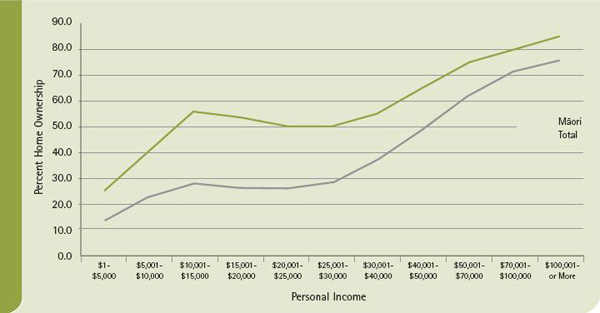Income
Personal income has a significant effect on Māori home ownership rates. 4 In 2006, there was a strong relationship between income and home ownership, with a high proportion of Māori with a personal income exceeding $100,000 owning their own homes (75.1 percent), and a significantly lower proportion of those with an income below $100,000 (30.8 percent).
Among the total population, 5 84.8 percent of those with a household income exceeding $100,000 lived in owner-occupied homes, compared with 53.0 percent of those with a household income below $100,000.
Between 2001 and 2006, Māori home ownership rates decreased across most income levels. The only exception to the general trend was the increase (up 1.2 percent to 75.1 percent) for individuals earning more than $100,000. There were significant declines in home ownership across a broad range of incomes, with decreases of greater than 6.8 percent from 2001 to 2006 for Māori with personal incomes anywhere between $20,001 and $70,000. The largest decreases occurred among Māori with an income of $30,001 - $40,000 (down 11.8 percent to 36.3 percent), and among those with an income of $40,001 to $50,000 (down 11.2 percent to 48.6 percent).
Graph 3: Home Ownership Rates for Māori and the Total Population by Personal Income in 2006

Source: Statistics New Zealand, Census of Population and Dwellings, 2006.
4 Dollar amounts are gross annual household income and have not been inflation-adjusted.
5 The total population refers to all people in New Zealand, including Māori.
